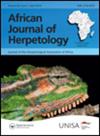Thermal physiology of Tropical House Geckos (Hemidactylus mabouia) in a cool temperate region of South Africa.
IF 0.9
4区 生物学
Q3 ZOOLOGY
引用次数: 0
Abstract
ABSTRACT Temperature profoundly influences the functioning of ectotherms and understanding the thermal biology of invasive species affords valuable insights regarding the suitability of different habitats. Yet, this remains an understudied aspect in the field of invasion biology. Here, we investigated the thermal physiology of the highly invasive Tropical House Gecko (Hemidactylus mabouia) in a coastal region of South Africa. The study site is near to the southernmost extent of the species’ distribution and we expected the physiology of individuals at the study site to differ compared to that of individuals inhabiting tropical regions. Relative to tropical geckos, we observed a decrease of 3.4°C in preferred body temperature (Tpref) to 24.0 °C, which was likely driven by selection for improved functioning within the cooler temperate climate. However, the lower (CTmin) and upper (CTmax) critical thermal limits were higher in geckos at the study site. CTmin was similar between sexes at 11.9 °C, whereas males had a higher CTmax by ≈ 1.9 °C reaching 39.7 °C. A broader tolerance range is typical of a highly variable climate, and we presume that the increase in CTmax allows geckos to better cope with occasional high temperatures. Further, sex-specific differences are uncommon in reptiles, but our study supports claims of improved heat tolerance in male geckos, argued to be related to their aggressive and territorial behaviour. The results also support claims that tropical geckos are more adaptable than previously thought, allowing them to invade new areas. Thereafter, their aggressive behaviour, dietary flexibility and year-round activity likely provides house geckos with a competitive advantage over some native reptiles.南非寒温带热带壁虎的热生理。
摘要温度深刻影响着外胚层的功能,了解入侵物种的热生物学为了解不同栖息地的适宜性提供了宝贵的见解。然而,在入侵生物学领域,这仍然是一个研究不足的方面。在这里,我们调查了南非沿海地区高度入侵的热带壁虎的热生理学。研究地点靠近该物种分布的最南端,我们预计研究地点的个体与居住在热带地区的个体的生理机能会有所不同。相对于热带壁虎,我们观察到偏好体温(Tpref)下降了3.4°C,降至24.0°C,这可能是由于在较冷的温带气候下选择改善功能。然而,研究地点壁虎的临界温度下限(CTmin)和上限(CTmax)较高。在11.9°C时,性别间的CTmin相似,而男性的CTmax高出≈1.9°C,达到39.7°C。更宽的耐受范围是高度可变气候的典型特征,我们认为CTmax的增加使壁虎能够更好地应对偶尔的高温。此外,爬行动物的性别差异并不常见,但我们的研究支持雄性壁虎耐热性提高的说法,认为这与它们的攻击性和领地行为有关。研究结果也支持了热带壁虎比以前认为的适应性更强的说法,使它们能够入侵新的地区。此后,它们的攻击性行为、饮食灵活性和全年活动可能为家壁虎提供了比一些本土爬行动物更具竞争力的优势。
本文章由计算机程序翻译,如有差异,请以英文原文为准。
求助全文
约1分钟内获得全文
求助全文
来源期刊

African Journal of Herpetology
ZOOLOGY-
CiteScore
3.00
自引率
6.70%
发文量
15
审稿时长
>12 weeks
期刊介绍:
African Journal of Herpetology (AJH) serves as an outlet for original research on the biology of African amphibians and reptiles. AJH is an interdisciplinary journal that publishes original articles and reviews from diverse fields and disciplines, such as conservation, phylogenetics, evolution, systematics, performance, physiology, ecology, behavioural ecology, ethology, and morphology.
The Journal publishes two issues a year. There are no page charges .
 求助内容:
求助内容: 应助结果提醒方式:
应助结果提醒方式:


